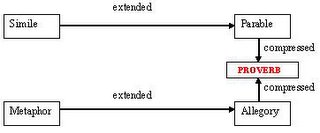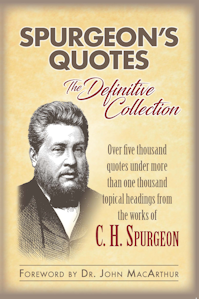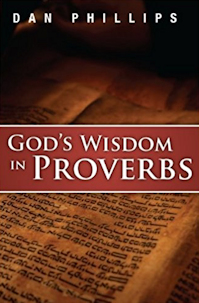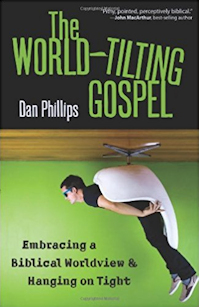The Plan: this is to be a three-part essay. First, we'll ponder some insights into interpreting proverbs. Then we'll actually develop a proverb on the basis of a couple of stories, one of them Biblical, the other not. Finally, we'll come back to apply what we've learned to interpreting, preaching and applying Biblical proverbs.
The Wisdom Books in general, and Proverbs in particular, have long been a special love of mine.
Proverbs is such a marvel, with such a breathtaking sweep of style and subject-matter. One proverb will plunge you into deep reflection ("Be assured, an evil person will not go unpunished, but the offspring of the righteous will be delivered" - 11:21) , and then the next will have you chuckling ("Like a gold ring in a pig's snout is a beautiful woman without discretion" - v. 22).
Proverbs so enthralled me that I did my Master's thesis on it. Now, a really good Master's thesis will always have a colon in the title, and I wanted mine to be really good. So I titled it The Sovereignty of Yahweh in the Book of Proverbs: an Exercise in Theological Exegesis. My typist accused me of putting most of the thesis in the footnotes. Maybe so; regardless, I had a terrific time studying and putting it together. Frank would hate some of the words I used, but I didn't know him then, and it was fun anyway. Since then there have been articles, seminars, studies; it still has its hold on me.
Still, Proverbs poses unique challenges. Some have used it as if it were a book of formulas: do A, and B will happen. To others, it's like a decoder-ring: if B happened, you must have done A. But many who have tried to work it that tightly have been very disappointed. They may end up wondering whether it means anything at all, or whether it's just a book of bromides and nice thoughts.
It is safe to say that in Proverbs we have a Wisdom book that requires wisdom for right handling.
For that reason, I love it when a writer or speaker opens up a new aspect of Proverbs, a new understanding, a new angle of approach. This was my experience when I recently read Henry Virkler's Hermeneutics: Principles and Processes of Biblical Interpretation (Baker: 1981).
In the course of discussing figures of speech such as similes, metaphors, proverbs, parables and allegories, Virkler brings out a sparkling insight. To get at it, let's brush up on a couple of definitions. A simile is the comparison of A to B, and a metaphor says that A is B. Virkler describes the former as an expressed comparison, and the latter as an unexpressed comparison (p. 158).
Proverbs 15:19 gives one example of each:
The way of a sluggard is like a hedge of thorns [simile],That's hardly original. But then Virkler observes that a simile, if extended, becomes a parable; and a metaphor, if extended, becomes an allegory. I'd never thought of it that way, and it's worth a thought.
but the path of the upright is a level highway [metaphor].
Then Virkler goes on to observe that if the parable or the allegory is compressed, it becomes -- you guessed it -- a proverb. On page 161, he illustrates it like this:

Genius, in that it simply won't do to read the book of Proverbs in a hurry. It isn't fast-food. Proverbs are meant to be chewed over, savored, relished slowly and thoroughly. We have to see through its brief statement, and unpack the larger story -- the parable or the allegory -- that lies behind it in the writer's thinking.
I'm really not much of a fan of the NIV, but the translators did one thing very right: they set off most of the proverbs beginning with chapter 10, putting a blank space in between each one. This signals that we're to chew each one over individually, before rushing on to the next.
But this compression factor is perilous to the interpreter, too. If we try to force the compressed form to say everything, we miss its point. It isn't always supposed to be a guarantee, or an exhaustive statement on any given subject. Rather, it is a pithy pointer, usually designed to drive one truth into the mind. Ryken says it well: "The aim of a proverb is to make an insight permanent" (Leland Ryken, How to Read the Bible as Literature [Zondervan: 1984], p. 122).
An insight; not all insight.
Let's practice this, then, in the next article. We'll lay out some extended insights in the forms of two eye-opening little stories. Then we'll see if we can't compress them into a proverb, and make the insight permanent.
UPDATE: this way to part two.












11 comments:
Awesome post. Can't wait for more.
Proverbs has been an untapped jewel, er, an itch waiting to be plumbed . . . or something. I really need these posts. Keep suggesting books too! Thanks, Dan!
I LOVE the chart!!
One of the techniques I use in teaching my children to write is to take a proverb and create a composition detailing what it means and how it is applicable.
Looking forward for more.
I see the proverbs as being like a baby smeradactyl slowly cracking open his shell.
Seriously, a very interesting post. I look forward to the follow-ups.
Thanks, you guys. Your encouragement is really appreciated; and stauf46, thanks for the chuckle.
That's a great idea Kim. What the next installment will attempt sounds like the other side of that coin, the reverse of the assignment you gave the kids: lay down a story or two, then form a proverb.
I know your other critics have already applauded you...
This is good stuff. I second the chart. It's really cool.
My kids have a Proverb every week that they have to explain to me. It's just filled with wonderful stuff. They should put it in a book or something, maybe with other books like a kind of... I don't know.. a "bible" or something.
Tulipgirl: whoa, do you do that often with your husband -- plucking out the unspoken thought that's right in the back of his head? Brr-r-r-r, scary!
(c8
Great stuff here.
I'm looking forward to more, dj. Of course, I see you've already posted the second part so I don't have to wait long.
I just wanted to encourage you and also to get you over the hump and into the double digits in number of comments. :>)
James -- I just wanted to encourage you and also to get you over the hump and into the double digits in number of comments. :>)
Woo hoo! And an emoticon from a Real Man, too! Thanks.
(c:
garet, I think Ryken would agree with you. He sees allegory as sort of a continuum, and argues that it has a place in Biblical interpretation. It's in disrepute for good reason -- abuses before and during the Middle Ages. But the corrective, in my mind, is always the grammatico-historical hermeneutic, and focusing on the author's/speaker's intent.
I think it'd be best to say some parables go more towards allegory (Good Samaritan, Prodigal Son), and more towards simile ("the kingdom of Heaven is like....").
Dan
Post a Comment